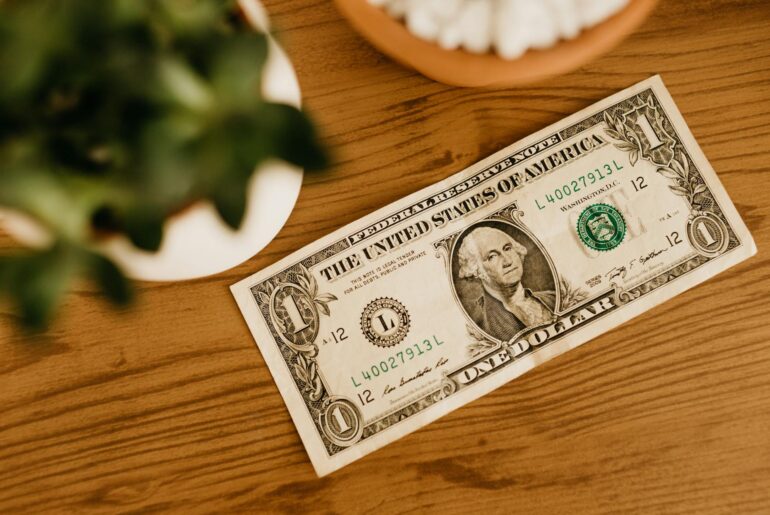This article may contain references to products or services from one or more of our advertisers or partners. We may receive compensation when you click on links to those products or services. Nonetheless, our opinions are our own.
The information presented in this article is accurate to the best of our knowledge at the time of publication. However, information is subject to change, and no guarantees are made about the continued accuracy or completeness of this content after its publication date.
If you’ve ever looked through your wallet, you might have found a strange one-dollar bill with a little star in the serial number. It may look like just another piece of money at first, but hold on to that bill for a second. You’re about to learn about the interesting world of star notes, which are bills that tell their own stories. We’ll talk about the history, purpose, and what these star-studded bills could mean for collectors like you. There is a lot to learn about these interesting notes, whether you are a serious numismatist or just interested in the strange things that happen with everyday money.
The Unique Significance of Star Notes
When you come across a one-dollar bill with a star, you’re holding a piece of currency that is more than just legal tender; it’s a collector’s gem. Star notes are designated by the star symbol replacing the last digit of the serial number, indicating that they are replacement notes issued when a bill is misprinted or damaged during production. This little detail makes star notes particularly intriguing for collectors and enthusiasts alike, as they tend to be rarer than their regular counterparts. Many collectors seek these notes not only for their scarcity but also because they often hold sentimental value, evoking a sense of nostalgia and connection to the past.
Here’s what makes star notes stand out:
- Rarity: Star notes are produced in smaller quantities, making them more sought after.
- Investment Potential: Due to their limited availability, star notes can increase in value over time.
- Historical Significance: Each star note has a story that goes along with how U.S. currency is made.
For those diving into the world of currency collecting, knowing the series date, condition, and serial number can greatly impact a star note’s value.
Here’s a simple comparison of factors that influence their worth:
| Factor | Impact on Value |
|---|---|
| Series Date | Older dates typically fetch higher prices. |
| Condition | Notes in pristine condition are worth considerably more. |
| Serial Number | Unique patterns or low numbers can increase desirability. |
When you find a star note in your wallet, it’s like finding a hidden treasure that proves you’re not just carrying cash but a piece of history. If you want to get the most out of your money, it’s important to know these little things, whether you’re a casual spender or a serious collector.
How Star Notes Are Created and Their Rarity
Not everyone knows about star notes, which are an interesting part of U.S. currency. When a regular note is damaged or fails inspection, these are basically replacement notes. The Bureau of Engraving and Printing makes a standard run of bills to start the process. The Bureau replaces any notes that are found to be misprinted or broken with notes that have a star symbol at the end of the serial number. This shows that they are replacements. This small detail not only makes the money stand out, but it also makes these notes harder to find. Star notes are usually less common than regular notes when it comes to rarity. Not all series of bills make the same number of star notes, which can make them worth a lot more to collectors.
The factors affecting rarity include:
- Series Year: Some years see higher production runs than others.
- Federal Reserve District: Notes from less frequently used Federal Reserve districts tend to be rarer.
- Condition: The better the condition of the note, the more collectors are willing to pay.
Here’s a quick look at how different factors can influence the value of star notes:
| Factor | Impact on Rarity |
| Series Year | Higher demand for older years leads to rarity. |
| District | Star notes from smaller FRB districts are less common. |
| Condition | Well-preserved notes command higher prices. |
For those who enjoy collecting, star notes can add a unique flair to your collection. Whether you choose to display them in a frame or save them for future investment, their unique status makes them a valuable addition to your collection.
Voted "Best Overall Budgeting App" by Forbes and WSJ
Monarch Money helps you budget, track spending, set goals, and plan your financial future—all in one app.
Get 50% OFF your first year with code MONARCHVIP
Evaluating the Value of Your Star Note
If you find a one-dollar bill with a star on it, it might be worth more than its face value. Star notes are made to replace bills that have been misprinted or damaged, which makes them a little mysterious and interesting to collectors. Not only is rarity a factor in determining their worth, but there are also other things that make them more appealing.
Here are some elements to consider:
- Condition: The physical state of the bill plays a meaningful role. Uncirculated notes are usually more valuable than those that have seen heavy usage.
- Series Year: Certain years may have produced fewer star notes, impacting their collectible value.
- Serial Number: Unique or low serial numbers can attract premium prices among enthusiasts.
To give you a clearer picture, here’s a simple comparison table of potential evaluation outcomes based on condition and rarity:
| Condition | Common Star Note Value | Rare Star Note Value |
| Circulated | $1 to $5 | $10 to $50 |
| Uncirculated | $5 to $15 | $100+ |
It can be fun to find a note like this, but you should carefully look at its features to understand how valuable it really is. Getting involved in online collector groups and price guides can also help you improve your evaluation process and meet other collectors who are eager to share their thoughts and experiences.
Conclusion
At first glance, star notes may look like regular bills, but they have an interesting history and are worth collecting. They add an extra level of excitement to everyday money because they can be used as replacement notes and are hard to find in different series. A star note is both a piece of American history and a possible investment for collectors. For people who don’t look for them, finding one is like finding a hidden treasure in your wallet.
Frequently Asked Questions
What does a one-dollar bill with a star symbolize?
A one-dollar bill with a star is a special version of the note that features a star symbol next to the serial number on its face. This star symbolizes that the bill is part of a replacement series, issued when a note in the regular series is misprinted or damaged during the manufacturing process.
Why are star notes considered special?
Star notes are considered special because they are less common than regular notes. Their rarity often makes them more sought after by collectors. The star indicates that it’s a replacement for a bill that didn’t meet the printing quality standards, which adds to its uniqueness.
How can I identify a star note?
To identify a star note, simply look at the serial number located on the front of the bill. If there’s a star symbol replacing one of the letters or numbers, it signifies that it’s a replacement note. The star will be positioned in the same spot as it would be if it were part of the standard numbering system.
What makes star notes valuable?
The value of star notes can be very different depending on how rare they are, how well they are kept, and how much collectors want them. Some star notes may only be worth a little more than their face value, but others, especially those that were made in small numbers or are in perfect condition, can sell for much more.
Where can I find star notes?
Star notes can sometimes be found in circulation, though they are becoming increasingly rare. You might also come across them at banks, currency exchanges, or through online auctions and collectible shops. Checking your own cash and reloading funds can also yield some discoveries.
How should I store a star note?
To preserve the condition of a star note, it’s best to store it in a protective sleeve or holder made for currency. Avoid folding or creasing the bill and keep it in a cool, dry place to protect it from moisture and other environmental factors that could cause damage.

Reviewed and edited by Albert Fang.
See a typo or want to suggest an edit/revision to the content? Use the contact us form to provide feedback.
At FangWallet, we value editorial integrity and open collaboration in curating quality content for readers to enjoy. Much appreciated for the assist.
Did you like our article and find it insightful? We encourage sharing the article link with family and friends to benefit as well - better yet, sharing on social media. Thank you for the support! 🍉
Article Title: What Makes a One Dollar Bill With a Star Special
https://fangwallet.com/2025/08/22/what-makes-a-one-dollar-bill-with-a-star-special/The FangWallet Promise
FangWallet is an editorially independent resource - founded on breaking down challenging financial concepts for anyone to understand since 2014. While we adhere to editorial integrity, note that this post may contain references to products from our partners.
The FangWallet promise is always to have your best interest in mind and be transparent and honest about the financial picture.
Become an Insider

Subscribe to get a free daily budget planner printable to help get your money on track!
Make passive money the right way. No spam.
Editorial Disclaimer: The editorial content on this page is not provided by any of the companies mentioned. The opinions expressed here are the author's alone.
The content of this website is for informational purposes only and does not represent investment advice, or an offer or solicitation to buy or sell any security, investment, or product. Investors are encouraged to do their own due diligence, and, if necessary, consult professional advising before making any investment decisions. Investing involves a high degree of risk, and financial losses may occur including the potential loss of principal.
Source Citation References:
+ Inspo
Martin, G. J. (2018). Dividing the dollar with formulas. The Journal of Politics, 80(2), 479-493.












































